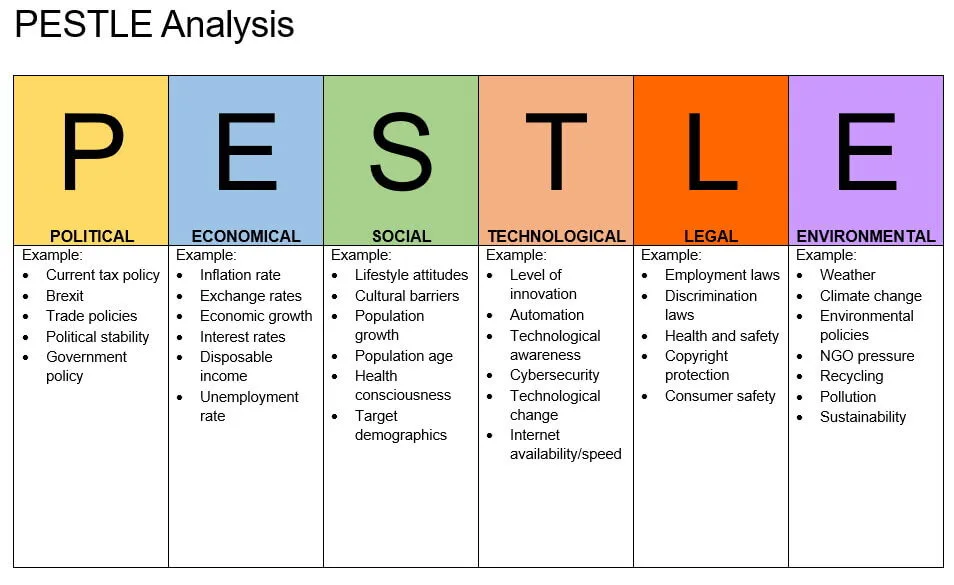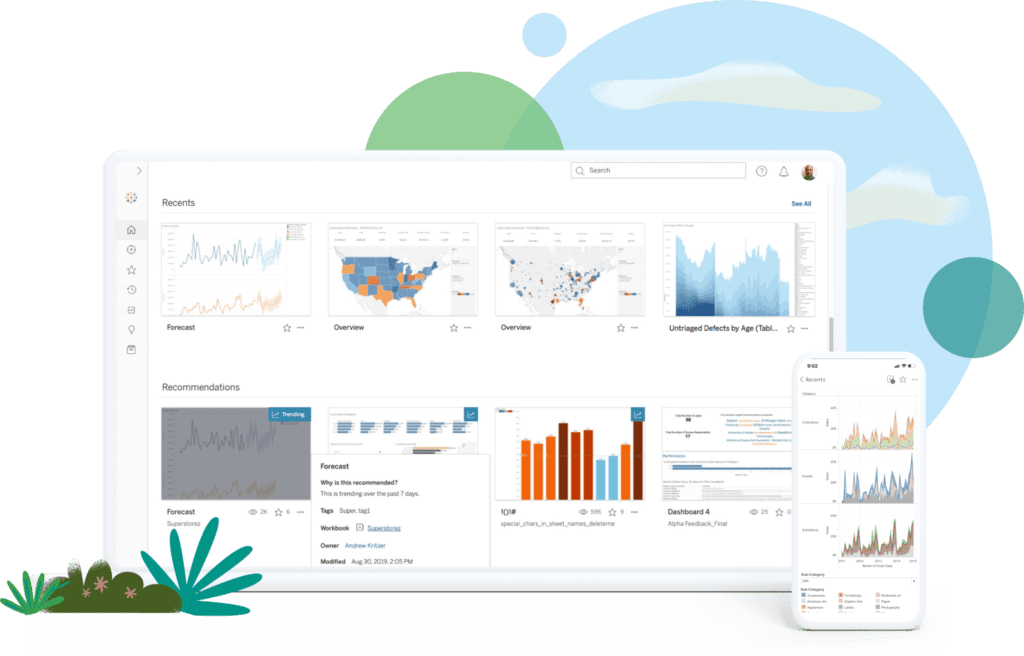Key Takeaways
- Master Strategic Decision-Making: Learn how PESTLE Analysis empowers businesses to make informed decisions by dissecting political, economic, social, technological, legal, and environmental factors.
- Avoid Pitfalls with Real-World Insights: Uncover lessons and sidestep common mistakes with practical guidance on updating, involving stakeholders, and continuous monitoring.
- Craft Resilient Strategies: Gain a holistic understanding of PESTLE Analysis to navigate risks, seize opportunities, and lay the foundation for long-term strategic planning. Arm your business with insights for sustained growth.
In the ever-evolving landscape of business, staying ahead of the curve requires more than just a keen intuition or a gut feeling.
Strategic decision-making demands a comprehensive understanding of the external factors that can shape the destiny of your enterprise.
This is where PESTLE Analysis comes into play, serving as a powerful compass that navigates through the intricate web of political, economic, social, technological, legal, and environmental influences.
If you’re wondering what PESTLE Analysis is and how it can be wielded as a potent tool for steering your business in the right direction, you’re in the right place.
In this comprehensive guide, we will delve deep into the intricacies of PESTLE Analysis, demystifying its components, unraveling its significance, and equipping you with the knowledge and tools to seamlessly integrate it into your strategic arsenal.

Unlocking the PESTLE Enigma
Before we embark on this enlightening journey, let’s unravel the acronym itself. PESTLE stands for Political, Economic, Social, Technological, Legal, and Environmental factors.
These elements collectively form the framework through which businesses can scrutinize the external forces that may impact their operations.
From the intricacies of government policies to the seismic shifts in technological landscapes, PESTLE Analysis is the ultimate reconnaissance mission that empowers businesses to anticipate, adapt, and thrive in a dynamic marketplace.
Why PESTLE Analysis Matters for Your Business
In a world characterized by rapid changes and unprecedented challenges, PESTLE Analysis serves as a strategic compass, providing a panoramic view of the factors that can make or break your business.
We will explore the profound importance of this analytical approach, shedding light on how it transcends mere trend analysis to become a cornerstone of informed decision-making.
An In-Depth Exploration of PESTLE Components
To truly harness the power of PESTLE Analysis, one must dissect and understand each component.
Throughout this guide, we will delve into the intricacies of the political landscape, navigate the economic currents, explore the social dynamics, decipher technological trends, unravel legal complexities, and navigate the ever-changing environmental terrain.
By comprehensively understanding these elements, you’ll be better equipped to conduct a thorough analysis tailored to your business needs.
The Strategic Benefits of PESTLE Analysis
The real value of PESTLE Analysis lies in its ability to transform information into actionable insights.
We’ll explore how this analytical framework contributes to strategic decision-making, aids in risk assessment and management, and uncovers hidden opportunities for growth.
A Step-by-Step Guide to Conducting PESTLE Analysis
Knowledge is power, and in the realm of strategic analysis, a systematic approach is paramount.
This guide will provide you with a step-by-step roadmap, from the initial stages of research and data collection to the nuanced evaluation of each PESTLE factor.
Whether you’re a seasoned executive or a budding entrepreneur, this guide will empower you to conduct a PESTLE Analysis tailored to your business context.
Embark on this journey with us as we unravel the enigma of PESTLE Analysis, providing you with the knowledge, insights, and practical tools needed to fortify your business against the uncertainties of the ever-changing business landscape.
It’s time to turn the tide in your favor, armed with the strategic prowess of PESTLE Analysis. Let’s dive in.
But, before we venture further, we like to share who we are and what we do.
About AppLabx
From developing a solid marketing plan to creating compelling content, optimizing for search engines, leveraging social media, and utilizing paid advertising, AppLabx offers a comprehensive suite of digital marketing services designed to drive growth and profitability for your business.
AppLabx is well known for helping companies and startups use digital marketing to drive web traffic to their websites and web apps.
At AppLabx, we understand that no two businesses are alike. That’s why we take a personalized approach to every project, working closely with our clients to understand their unique needs and goals, and developing customized strategies to help them achieve success.
If you need a digital consultation, then send in an inquiry here.
What is PESTLE Analysis and How To Do It For Your Business?
- Understanding PESTLE Analysis
- Benefits of PESTLE Analysis
- Steps to Conduct PESTLE Analysis for Your Business
- Common Mistakes to Avoid
1. Understanding PESTLE Analysis
In the labyrinth of strategic analysis, understanding the intricacies of PESTLE Analysis is akin to holding a master key that unlocks valuable insights into the external forces shaping your business landscape.
Let’s break down the acronym, delving into the core components that constitute this powerful analytical framework.

The P in PESTLE: Political Factors
Political factors encompass the influence of government policies, regulations, and political stability on your business.
Understanding these dynamics is pivotal, as shifts in political landscapes can have profound implications.
Example: Consider the impact of Brexit on businesses operating in the UK and the European Union. The political upheaval resulted in changes in trade regulations, tariffs, and supply chain disruptions, affecting industries across sectors.
The E in PESTLE: Economic Factors
Economic factors delve into the economic conditions that can shape the success or challenges faced by your business. Variables such as inflation rates, exchange rates, and economic growth play a crucial role in this analysis.
Example: The global financial crisis of 2008 had far-reaching consequences on businesses worldwide. The economic downturn led to decreased consumer spending, tighter credit markets, and a profound impact on industries ranging from finance to manufacturing.
The S in PESTLE: Social Factors
Social factors examine the societal influences on your business, including demographic trends, cultural shifts, and consumer behaviors. Understanding these aspects is vital for aligning products and services with evolving societal needs.
Example: The rise of social media has revolutionized marketing strategies for businesses. Companies now leverage platforms like Instagram and TikTok to engage with younger demographics, reshaping the landscape of consumer interaction.
The T in PESTLE: Technological Factors
Technological factors explore the impact of innovation, automation, and technological advancements on your business. Staying abreast of these changes is essential for maintaining competitiveness.
The L in PESTLE: Legal Factors
Legal factors encompass the influence of laws, regulations, and legal frameworks on your business operations. Compliance with these factors is not only ethical but also crucial for avoiding legal pitfalls.
Example: The introduction of the General Data Protection Regulation (GDPR) in the European Union compelled businesses globally to reevaluate their data protection practices.
Non-compliance could result in hefty fines, prompting a widespread reassessment of data handling processes.

The E in PESTLE: Environmental Factors
Environmental factors focus on the impact of ecological aspects on your business.
With increasing environmental consciousness, businesses need to consider sustainability, climate change, and environmental regulations.
Example: The automotive industry has witnessed a paradigm shift towards electric vehicles (EVs) due to environmental concerns and regulatory pressures to reduce carbon emissions.
Companies investing in EV technology position themselves strategically in this evolving landscape.
Navigating the Interconnected Web
Understanding PESTLE Analysis is not merely a checklist exercise; it’s about recognizing the interconnectedness of these factors.
Political decisions can influence economic conditions, societal trends drive technological advancements, and legal changes impact environmental considerations.
As businesses operate in this intricate web, a nuanced understanding of these relationships becomes imperative.
The Data-backed Imperative
Understanding PESTLE Analysis is not a speculative endeavor; it demands a data-backed approach.
Businesses can leverage statistical data and market research to quantify the impact of these factors.
For instance, analyzing economic indicators like GDP growth rates or unemployment rates provides tangible insights into economic stability and consumer purchasing power.
2. Benefits of PESTLE Analysis
In the dynamic landscape of business, strategic decision-making is a constant tightrope walk.
Embracing the PESTLE Analysis framework not only adds stability to this process but also unlocks a myriad of strategic benefits that can propel your business forward.

Strategic Decision-Making Precision
One of the paramount advantages of PESTLE Analysis lies in its ability to provide a comprehensive view of the external factors influencing your business.
By meticulously scrutinizing political, economic, social, technological, legal, and environmental dimensions, businesses can make informed decisions grounded in a holistic understanding of the prevailing conditions.
PESTLE Analysis, when integrated with data analytics, enhances decision-making precision by offering quantifiable insights into external factors.
Risk Assessment and Management
In an environment rife with uncertainties, businesses must be adept at risk assessment and management.
PESTLE Analysis serves as a robust risk assessment tool, allowing organizations to identify potential threats and devise proactive strategies to mitigate risks.

Opportunity Identification and Exploitation
Beyond risk mitigation, PESTLE Analysis is a beacon for identifying opportunities that may otherwise go unnoticed.
By discerning trends and shifts in the external environment, businesses can position themselves strategically to capitalize on emerging opportunities.
Stakeholder Confidence and Communication
For businesses to thrive, maintaining the confidence of stakeholders is paramount.
PESTLE Analysis not only facilitates internal decision-making but also serves as a valuable communication tool.
Transparently communicating the external factors influencing business strategies enhances stakeholder confidence and fosters a collaborative environment.
Stakeholder Confidence: PESTLE Analysis provides the transparency stakeholders seek by showcasing the comprehensive evaluation of external influences.
Long-Term Strategic Planning
Businesses that aspire to longevity understand the importance of long-term strategic planning.
PESTLE Analysis, with its forward-looking approach, equips organizations to formulate strategies that are not only effective in the present but also resilient in the face of future uncertainties.
Sustainable Practices: Environmental factors within PESTLE Analysis emphasize the importance of sustainable practices. A whopping 81% of global respondents feel strongly that companies should help improve the environment.
Integrating environmental considerations into long-term strategies aligns with consumer expectations and promotes sustainable business practices.
3. Steps to Conduct PESTLE Analysis for Your Business
Embarking on the journey of PESTLE Analysis requires a systematic approach that encompasses thorough research, critical evaluation, and strategic synthesis.
In this section, we’ll unravel the step-by-step process to guide you in conducting a robust PESTLE Analysis tailored to your business needs.

Research and Data Collection
Before delving into the analysis, laying a strong foundation through comprehensive research and data collection is essential.
Gather relevant information from reliable sources to ensure a well-informed assessment.
Online Databases and Reports: Utilize platforms like Statista, World Bank, and industry-specific databases to access up-to-date statistical data. For instance, Statista provides a wealth of economic indicators that can inform the economic factor in your analysis.

Analyzing Political Factors
Political factors set the stage for business operations, and understanding their impact is crucial.
Analyze government stability, policies, and geopolitical influences that may affect your industry.
Example: The political landscape in the healthcare industry is heavily influenced by government policies.
Assessing Economic Factors
Economic conditions shape the financial climate in which businesses operate.
Evaluate factors such as inflation rates, exchange rates, and economic growth to gauge the economic viability of your business environment.
Data-Driven Analysis: Utilize economic indicators like GDP growth rates and unemployment rates to quantify economic conditions.
For instance, during economic recessions, businesses often experience reduced consumer spending, impacting various industries.
Examining Social Factors
Social dynamics, including demographic trends and cultural shifts, play a pivotal role in shaping consumer behavior.
Explore societal attitudes, lifestyle changes, and population demographics relevant to your business.
Cultural Impact on Consumer Behavior: For instance, the rising trend of sustainability and ethical consumerism has compelled businesses to adapt their practices to align with changing societal values.
Evaluating Technological Factors
In the digital age, technological factors are paramount.
Assess the impact of technological advancements, innovation, and the pace of change within your industry.
Example: The adoption of Artificial Intelligence (AI) and automation in manufacturing has revolutionized production processes, enhancing efficiency and reducing costs.

Considering Legal Factors
Legal considerations encompass regulations, laws, and compliance issues.
Evaluate the legal framework governing your industry and ensure compliance to avoid legal pitfalls.
Regulatory Compliance: The introduction of the General Data Protection Regulation (GDPR) in the European Union compelled businesses globally to reassess their data protection practices to ensure compliance.
Reviewing Environmental Factors
Environmental factors focus on sustainability, climate change, and ecological impacts.
Assess how your business operations align with environmental regulations and ethical considerations.
Sustainable Practices: Companies in various industries are increasingly adopting sustainable practices to meet consumer expectations and comply with environmental regulations.
4. Common Mistakes to Avoid
While PESTLE Analysis is a potent strategic tool, its effectiveness hinges on meticulous execution.
In this section, we’ll explore common mistakes businesses often make during the PESTLE Analysis process and provide insights on how to steer clear of these pitfalls.

Overlooking Certain Factors
In the pursuit of a comprehensive analysis, businesses may inadvertently overlook or underestimate the significance of certain PESTLE factors.
Neglecting any component can lead to an incomplete understanding of the external forces impacting the business environment.
Example: In the context of the pharmaceutical industry, businesses focusing solely on technological factors may overlook the nuanced impact of evolving legal and environmental regulations on drug development and distribution.
Neglecting Updates and Changes
The business landscape is dynamic, with factors constantly evolving.
Failing to regularly update the PESTLE Analysis can result in outdated strategic decisions, rendering the analysis ineffective over time.
Failing to Involve Key Stakeholders
PESTLE Analysis is most effective when it incorporates diverse perspectives.
Failing to involve key stakeholders, including employees, customers, and industry experts, can lead to a skewed analysis and oversight of critical factors.
Employee Involvement: Involving employees in the PESTLE Analysis process ensures a more comprehensive understanding of internal and external dynamics.
Best Practices for Mitigating Mistakes
Learning from the missteps of others, businesses can adopt best practices to mitigate common mistakes and enhance the effectiveness of their PESTLE Analysis.
Regularly Update and Reassess
To counter the dynamic nature of the business environment, implement a regular schedule for updating and reassessing the PESTLE Analysis.
This ensures that strategic decisions remain aligned with the latest external influences.
Industry Benchmarking: Benchmarking against industry standards and conducting periodic reviews help identify emerging trends and changes that may impact your business.
Implement a Cross-Functional Approach
Encourage a cross-functional approach by involving employees from various departments in the PESTLE Analysis process.
This diversity of perspectives ensures a more comprehensive evaluation of factors and reduces the likelihood of oversight.
Data-Driven Collaboration: Platforms that facilitate collaborative data analysis, such as Tableau or Power BI, can enhance cross-functional collaboration by providing a centralized space for data-driven discussions.

Utilize Technology for Continuous Monitoring
Leverage technological tools and platforms for continuous monitoring of external factors.
Automated alerts and analytics dashboards can provide real-time insights, enabling businesses to stay agile and responsive to changes.
AI-Powered Analytics: Incorporating artificial intelligence (AI) into data analysis processes enhances the ability to predict and respond to changes in the business environment, reducing the risk of overlooking critical factors.
Conclusion
In the labyrinth of business strategy, where uncertainties lurk and market dynamics continually evolve, PESTLE Analysis emerges as a formidable ally.
As we draw the curtains on this extensive exploration, the significance of PESTLE Analysis in empowering businesses to make informed decisions cannot be overstated.
Let’s unravel the layers and glean insights that will propel your business toward strategic excellence.
The Holistic Lens of PESTLE Analysis
At its core, PESTLE Analysis acts as a panoramic lens, revealing the intricate interplay of political, economic, social, technological, legal, and environmental factors that weave the tapestry of a business environment.
This comprehensive understanding becomes the cornerstone upon which businesses can build resilient strategies capable of withstanding the complexities of the external landscape.
Precision in Strategic Decision-Making
The true power of PESTLE Analysis lies in its ability to bring precision to strategic decision-making.
No longer confined to intuition or conjecture, businesses armed with data-driven insights can navigate the strategic landscape with confidence.
Each component of the analysis contributes to a more nuanced comprehension, allowing for strategic decisions that resonate with the pulse of the market.
Navigating Risks and Seizing Opportunities
As businesses set sail in turbulent seas, PESTLE Analysis serves as the navigational chart, pinpointing potential risks on the horizon while also highlighting uncharted opportunities.
The ability to anticipate challenges and capitalize on emerging trends becomes a competitive advantage, positioning businesses not merely as passive actors but as architects of their own destinies.
Transparent Communication and Stakeholder Confidence
Transparency is the currency that fosters trust in the realm of business.
PESTLE Analysis is not just an internal tool; it is a communication medium that bridges the gap between decision-makers and stakeholders.
By transparently showcasing the external factors shaping strategies, businesses cultivate stakeholder confidence, fostering a collaborative environment essential for sustained success.
Long-Term Strategic Planning: A Guiding Light
In the race for longevity, businesses need more than short-term tactics; they require a compass for long-term strategic planning.
PESTLE Analysis, with its forward-looking approach, provides precisely that.
It allows organizations to craft strategies that withstand the test of time, ensuring adaptability and resilience in the face of an ever-changing business landscape.
Implementing PESTLE Analysis: Next Steps
As we bid adieu to this comprehensive guide, the journey doesn’t end; it transforms.
Implementing PESTLE Analysis is not a static endeavor but an ongoing process.
Regular updates, cross-functional collaboration, and leveraging technology for continuous monitoring are the next steps.
Businesses are encouraged to take these insights, integrate them into their strategic fabric, and embark on a journey marked by adaptability, resilience, and sustained growth.
Your North Star in the Strategic Odyssey
In the ever-evolving business landscape, PESTLE Analysis emerges as your North Star – a guiding light that illuminates the strategic path, helping businesses navigate uncertainties and make decisions rooted in insights.
Armed with the knowledge from this guide, your business is poised not just to survive but to thrive in the intricate tapestry of the market.
Safe Travels on Your Strategic Odyssey
As you set sail on the strategic odyssey armed with the insights of PESTLE Analysis, may your journey be marked by informed decisions, proactive adaptations, and triumphs in the face of challenges. Safe travels as you chart your course to strategic excellence.
If you are looking for a top-class digital marketer, then book a free consultation slot here.
If you find this article useful, why not share it with your friends and business partners, and also leave a nice comment below?
We, at the AppLabx Research Team, strive to bring the latest and most meaningful data, guides, and statistics to your doorstep.
To get access to top-quality guides, click over to the AppLabx Blog.
People also ask
How to do a PESTLE analysis for a business?
To conduct a PESTLE analysis for your business, identify and evaluate Political, Economic, Social, Technological, Legal, and Environmental factors. Research industry trends, gather data, and assess the impact of these factors on your operations. Use the insights gained to inform strategic decision-making.
How do you score a PESTLE analysis?
Scoring a PESTLE analysis involves assigning weight and relevance to each factor based on its impact on the business. Rate factors on a scale, considering their significance. Sum the scores to prioritize key elements. The higher the score, the more crucial the factor in shaping strategic decisions.
What is a PESTLE analysis for a local business?
For a local business, a PESTLE analysis assesses Political, Economic, Social, Technological, Legal, and Environmental factors specific to its geographical area. It evaluates local regulations, economic conditions, community dynamics, technological trends, legal requirements, and environmental influences, guiding the business in tailoring strategies to the unique local context.
What is PESTLE Analysis?
PESTLE analysis is a strategic tool used to assess the external macro-environmental factors that can impact a business. It stands for Political, Economic, Social, Technological, Legal, and Environmental factors.
Why is PESTLE Analysis Important for Businesses?
PESTLE analysis helps businesses identify opportunities and threats arising from external factors. It informs strategic decision-making, risk management, and adaptation to changes in the business environment.
How Do You Conduct a PESTLE Analysis?
- Identify Factors: List political, economic, social, technological, legal, and environmental factors relevant to your business.
- Gather Information: Research each factor’s current trends, developments, and potential impacts.
- Analyze Impact: Assess how each factor may influence your business operations, market dynamics, and future prospects.
- Strategic Implications: Determine strategic implications and potential actions based on your analysis.
What Political Factors Should I Consider in PESTLE Analysis?
Examine government stability, regulations, trade policies, and political stability. Evaluate how political decisions and events may affect your industry, market access, or business operations.
What Economic Factors Are Important in PESTLE Analysis?
Analyze economic indicators, market trends, inflation rates, and currency fluctuations. Consider factors like GDP growth, consumer spending, and interest rates that can impact business performance.
How Do Social Factors Impact PESTLE Analysis?
Assess societal trends, demographics, cultural shifts, and consumer behaviors. Consider social attitudes, lifestyle changes, and emerging preferences that may influence demand for your products or services.
What Technological Factors Should I Include in the PESTLE Analysis?
Evaluate technological advancements, innovation, automation, and digital disruption. Identify opportunities and threats arising from new technologies, industry trends, and competitive developments.
What Legal Factors Are Relevant in PESTLE Analysis?
Examine laws, regulations, compliance requirements, and litigation risks affecting your industry. Consider legal frameworks related to employment, intellectual property, consumer protection, and data privacy.
How Do Environmental Factors Factor into PESTLE Analysis?
Assess environmental regulations, sustainability initiatives, climate change risks, and resource availability. Consider the impact of environmental concerns on business operations, supply chains, and brand reputation.
Can PESTLE Analysis Help Forecast Future Trends?
While PESTLE analysis provides insights into current factors, it can also inform future scenarios and trends. By understanding external influences, businesses can anticipate shifts and adapt their strategies accordingly.
How Often Should I Conduct a PESTLE Analysis?
Regularly review and update your PESTLE analysis to stay abreast of changing external factors. Conduct it annually or in response to significant events, industry shifts, or changes in the competitive landscape.
How Does PESTLE Analysis Complement SWOT Analysis?
PESTLE analysis focuses on external factors, while SWOT analysis assesses internal strengths, weaknesses, opportunities, and threats. Combining both frameworks provides a comprehensive understanding of business environments and informs strategic planning.
Can PESTLE Analysis Help Mitigate Risks?
Yes, by identifying potential threats early, businesses can develop risk mitigation strategies. PESTLE analysis enables proactive risk management and helps businesses navigate uncertainties in their operating environments.
How Can I Apply PESTLE Analysis in Different Business Functions?
PESTLE analysis can inform various business functions, including marketing, operations, finance, and human resources. Use it to assess market opportunities, regulatory compliance, investment decisions, and talent management strategies.
Is PESTLE Analysis Suitable for Small Businesses?
Yes, PESTLE analysis is valuable for businesses of all sizes. Small businesses can use it to understand market dynamics, identify growth opportunities, and anticipate challenges in their operating environments.
Can PESTLE Analysis Help Businesses Stay Competitive?
Absolutely, by providing insights into external factors, PESTLE analysis equips businesses to adapt to changing environments and stay competitive. It enables strategic decision-making, innovation, and effective resource allocation.
How Can I Access Resources to Conduct a PESTLE Analysis?
Utilize online databases, industry reports, government publications, and market research to gather information for PESTLE analysis. Engage with industry experts, attend conferences, and network to stay informed about relevant trends and developments.
What Are the Limitations of PESTLE Analysis?
PESTLE analysis may oversimplify complex environments, overlook interdependencies, or fail to predict black swan events. It’s important to supplement it with other strategic frameworks and critical thinking to enhance decision-making.
How Can I Ensure PESTLE Analysis is Integrated into Strategic Planning?
Integrate PESTLE analysis into strategic planning processes and decision-making frameworks. Ensure that insights from the analysis inform business strategies, goals, and action plans across all organizational levels.
Can PESTLE Analysis Help Businesses Prepare for Global Expansion?
Yes, PESTLE analysis is instrumental in assessing risks and opportunities in new markets. It helps businesses understand cultural, regulatory, and economic differences, guiding strategic decisions during global expansion initiatives.




































